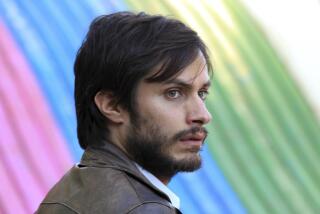MOVIE REVIEW : The Art of Filming the Impossible
The central image of the luminous, mesmerizing “A Tale of the Wind” (at the Nuart) is that of an elderly man sitting on a chair atop a sand dune in China’s Gobi Desert. He is Joris Ivens, renowned 90-year-old Dutch-born documentarian, who is waiting for a wind to come so that he may tame it. This he cannot really do and knows it, but says, “Filming the impossible is what’s best in life.”
For more than 60 years, the peripatetic Ivens had recorded virtually every war and the countless struggles for justice, always on the side of the oppressed. Inspired by an idea of his collaborator of 25 years, Marceline Louridan, he would now return with her to his beloved China, where he had so frequently filmed for half a century. This time would be different: no more preoccupation with war or politics.
“As a filmmaker, I think we have to dare to enter the no-man’s land between reality and imagination, documentary and fiction,” he said of “A Tale of the Wind.”
“Poetry beyond reality.” No filmmaker has described his intention and accomplishment more accurately, for that is precisely where “A Tale of the Wind” takes us. Rather than tame the wind when it finally arrives, Ivens celebrates it as it generates sand storms and sculpts and resculpts the desert landscape. Confronting the wind as an artist and a man becomes for Ivens a mystical communion with nature, the culmination of a meditation on life, death and the universe.
Ivens, who died in June, 1989, did not intend this film, shot the previous year, as his valedictory. However, as an asthmatic nonagenarian “with half a lung at my disposal,” he surely must have realized it most likely would be. As a contemplative summing up with a sense of elegance and grandeur, it recalls Jean Cocteau’s famous farewell to the cinema, “The Testament of Orpheus.”
“A Tale of the Wind” is surely as much Louridan’s movie--perhaps even more--than it is Ivens’ for it is, above all, a warm portrait of Ivens, a stylish man of striking leonine appearance, his strong, noble face framed by a long silver mane. Before it proceeds to its glorious, enigmatic finale, it unfolds like a diary, a film about its own difficult making, and a reminiscence as Ivens jousts with bureaucrats on the one hand and, on the other, revisits familiar locales.
However, despite its easy, informal documentary style, there is throughout a sense of foreboding of mystical experience--indeed, death itself--as a mime with a grotesque, sinister mask recurs frequently, serving as the film’s key motif.
On a sound stage Ivens and Louridan mount a series of tableaux, expressing their fears of the seduction of China by Western-style materialism, and they visit such exotic locales as the site of the Buddha of Dazu with its 1,000 “comforting arms.”
In its most charming moment, “A Tale of the Wind” (Times-rated Family) presents an enchanting fantasy that imagines Ivens a passenger on the rocket in Georges Melies’ landmark “A Trip to the Moon” (1902). It’s one of the few places Ivens never actually visited.
‘A Tale of the Wind’
A Film Tribe release of a co-production of Capi Films/La S.E.P.T. with the participation of the Ministry of Culture (France) and Stichting Fonds voor de Nederlandse Film (Holland). Directors Joris Ivens, Marceline Louridan. Executive producer Louridan. Screenplay Ivens, Louridan, with Elizabeth D. Camera Thierry Arbogast, Jacques Loiseleux. Editor Genevieve Louveau. Music Michael Portal. In French, with English subtitles. Running time: 1 hour, 17 minutes.
Times-rated Family (suitable for all ages).
More to Read
Only good movies
Get the Indie Focus newsletter, Mark Olsen's weekly guide to the world of cinema.
You may occasionally receive promotional content from the Los Angeles Times.









